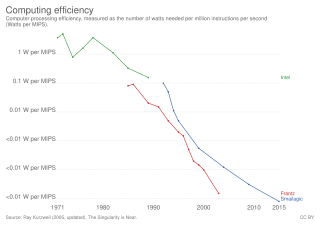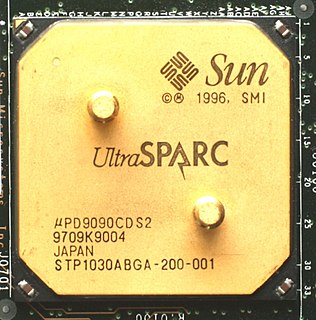
A central processing unit (CPU), also called a central processor, main processor or just processor, is the electronic circuitry within a computer that executes instructions that make up a computer program. The CPU performs basic arithmetic, logic, controlling, and input/output (I/O) operations specified by the instructions in the program. The computer industry used the term "central processing unit" as early as 1955. Traditionally, the term "CPU" refers to a processor, more specifically to its processing unit and control unit (CU), distinguishing these core elements of a computer from external components such as main memory and I/O circuitry.

Frederick Phillips "Fred" Brooks Jr. is an American computer architect, software engineer, and computer scientist, best known for managing the development of IBM's System/360 family of computers and the OS/360 software support package, then later writing candidly about the process in his seminal book The Mythical Man-Month. Brooks has received many awards, including the National Medal of Technology in 1985 and the Turing Award in 1999.

A microprocessor is a computer processor that incorporates the functions of a central processing unit on a single integrated circuit (IC) of MOSFET construction. The microprocessor is a multipurpose, clock-driven, register-based, digital integrated circuit that accepts binary data as input, processes it according to instructions stored in its memory, and provides results as output. Microprocessors contain both combinational logic and sequential digital logic. Microprocessors operate on numbers and symbols represented in the binary number system.
Microcode is a computer hardware technique that interposes a layer of organisation between the CPU hardware and the programmer-visible instruction set architecture of the computer. As such, the microcode is a layer of hardware-level instructions that implement higher-level machine code instructions or internal state machine sequencing in many digital processing elements. Microcode is used in general-purpose central processing units, although in current desktop CPUs, it is only a fallback path for cases that the faster hardwired control unit cannot handle.

Instructions per second (IPS) is a measure of a computer's processor speed. For CISC computers different instructions take different amounts of time, so the value measured depends on the instruction mix; even for comparing processors in the same family the IPS measurement can be problematic. Many reported IPS values have represented "peak" execution rates on artificial instruction sequences with few branches and no cache contention, whereas realistic workloads typically lead to significantly lower IPS values. Memory hierarchy also greatly affects processor performance, an issue barely considered in IPS calculations. Because of these problems, synthetic benchmarks such as Dhrystone are now generally used to estimate computer performance in commonly used applications, and raw IPS has fallen into disuse.

A reduced instruction set computer, or RISC, is a computer with a small, highly optimized set of instructions, rather than the more specialized set often found in other types of architecture, such as in a complex instruction set computer (CISC). The main distinguishing feature of RISC architecture is that the instruction set is optimized with a large number of registers and a highly regular instruction pipeline, allowing a low number of clock cycles per instruction (CPI). Another common RISC feature is the load/store architecture, in which memory is accessed through specific instructions rather than as a part of most instructions in the set.
The NS32000, sometimes known as the 32k, is a series of microprocessors produced by National Semiconductor. The first member of the family, the 32016, came to market in 1982, making it the first 32-bit general-purpose microprocessor on the market. However, the 32016 contained a large number of bugs and often could not be run at its rated speed. These problems, and the presence of the similar Motorola 68000 which had been available for some time, led to almost no use in the market.

IA-64 is the instruction set architecture (ISA) of the Itanium family of 64-bit Intel microprocessors. The basic ISA specification originated at Hewlett-Packard (HP), and was evolved and then implemented in a new processor microarchitecture by Intel with HP's continued partnership and expertise on the underlying EPIC design concepts. In order to establish what was their first new ISA in 20 years and bring an entirely new product line to market, Intel made a massive investment in product definition, design, software development tools, OS, software industry partnerships, and marketing. To support this effort Intel created the largest design team in their history and a new marketing and industry enabling team completely separate from x86. The first Itanium processor, codenamed Merced, was released in 2001.

The transputer is a series of pioneering microprocessors from the 1980s, featuring integrated memory and serial communication links, intended for parallel computing. They were designed and produced by Inmos, a semiconductor company based in Bristol, United Kingdom.

Parallel computing is a type of computation where many calculations or the execution of processes are carried out simultaneously. Large problems can often be divided into smaller ones, which can then be solved at the same time. There are several different forms of parallel computing: bit-level, instruction-level, data, and task parallelism. Parallelism has long been employed in high-performance computing, but has gained broader interest due to the physical constraints preventing frequency scaling. As power consumption by computers has become a concern in recent years, parallel computing has become the dominant paradigm in computer architecture, mainly in the form of multi-core processors.
ARX was an unreleased Mach-like operating system written in Modula-2+ developed by Acorn Computers Ltd in the Acorn Research Centre (ARC) United Kingdom (UK) and later Olivetti Research Center and later on Software Technology Laboratory at Palo Alto, California for their new ARM architecture reduced instruction set computer (RISC) central processing unit (CPU) based Archimedes personal computers.

John Leroy Hennessy is an American computer scientist, academician, businessman, and Chair of Alphabet Inc. Hennessy is one of the founders of MIPS Computer Systems Inc. as well as Atheros and served as the tenth President of Stanford University. Hennessy announced that he would step down in the summer of 2016. He was succeeded as President by Marc Tessier-Lavigne. Marc Andreessen called him "the godfather of Silicon Valley."
KDF9 was an early British computer designed and built by English Electric. The first machine came into service in 1964 and the last of 29 machines was decommissioned in 1980 at the National Physical Laboratory. The KDF9 was designed for, and used almost entirely in, the mathematical and scientific processing fields – in 1967, nine were in use in UK universities and technical colleges. The KDF8, developed in parallel, was aimed at commercial processing workloads.

In computer engineering, microarchitecture, also called computer organization and sometimes abbreviated as µarch or uarch, is the way a given instruction set architecture (ISA) is implemented in a particular processor. A given ISA may be implemented with different microarchitectures; implementations may vary due to different goals of a given design or due to shifts in technology.
In digital electronics, an asynchronous circuit, or self-timed circuit, is a sequential digital logic circuit which is not governed by a clock circuit or global clock signal. Instead it often uses signals that indicate completion of instructions and operations, specified by simple data transfer protocols. This type of circuit is contrasted with synchronous circuits, in which changes to the signal values in the circuit are triggered by repetitive pulses called a clock signal. Most digital devices today use synchronous circuits. However asynchronous circuits have the potential to be faster, and may also have advantages in lower power consumption, lower electromagnetic interference, and better modularity in large systems. Asynchronous circuits are an active area of research in digital logic design.

A multi-core processor is a computer processor integrated circuit with two or more separate processing units, called cores, each of which reads and executes program instructions, as if the computer had several processors. The instructions are ordinary CPU instructions but the single processor can run instructions on separate cores at the same time, increasing overall speed for programs that support multithreading or other parallel computing techniques. Manufacturers typically integrate the cores onto a single integrated circuit die or onto multiple dies in a single chip package. The microprocessors currently used in almost all personal computers are multi-core.

The VIA Nano is a 64-bit CPU for personal computers. The VIA Nano was released by VIA Technologies in 2008 after five years of development by its CPU division, Centaur Technology. This new Isaiah 64-bit architecture was designed from scratch, unveiled on 24 January 2008, and launched on May 29, including low-voltage variants and the Nano brand name. The processor supports a number of VIA-specific x86 extensions designed to boost efficiency in low-power appliances.
Barrelfish is an experimental computer operating system built by ETH Zurich with the assistance of Microsoft Research in Cambridge. It is an experimental operating system designed from the ground up for scalability for computers built with multi-core processors with the goal of reducing the compounding decrease in benefit as more CPUs are used in a computer via putting low level hardware information in a database, removing the necessity for driver software.

In computer engineering, computer architecture is a set of rules and methods that describe the functionality, organization, and implementation of computer systems. Some definitions of architecture define it as describing the capabilities and programming model of a computer but not a particular implementation. In other definitions computer architecture involves instruction set architecture design, microarchitecture design, logic design, and implementation.












